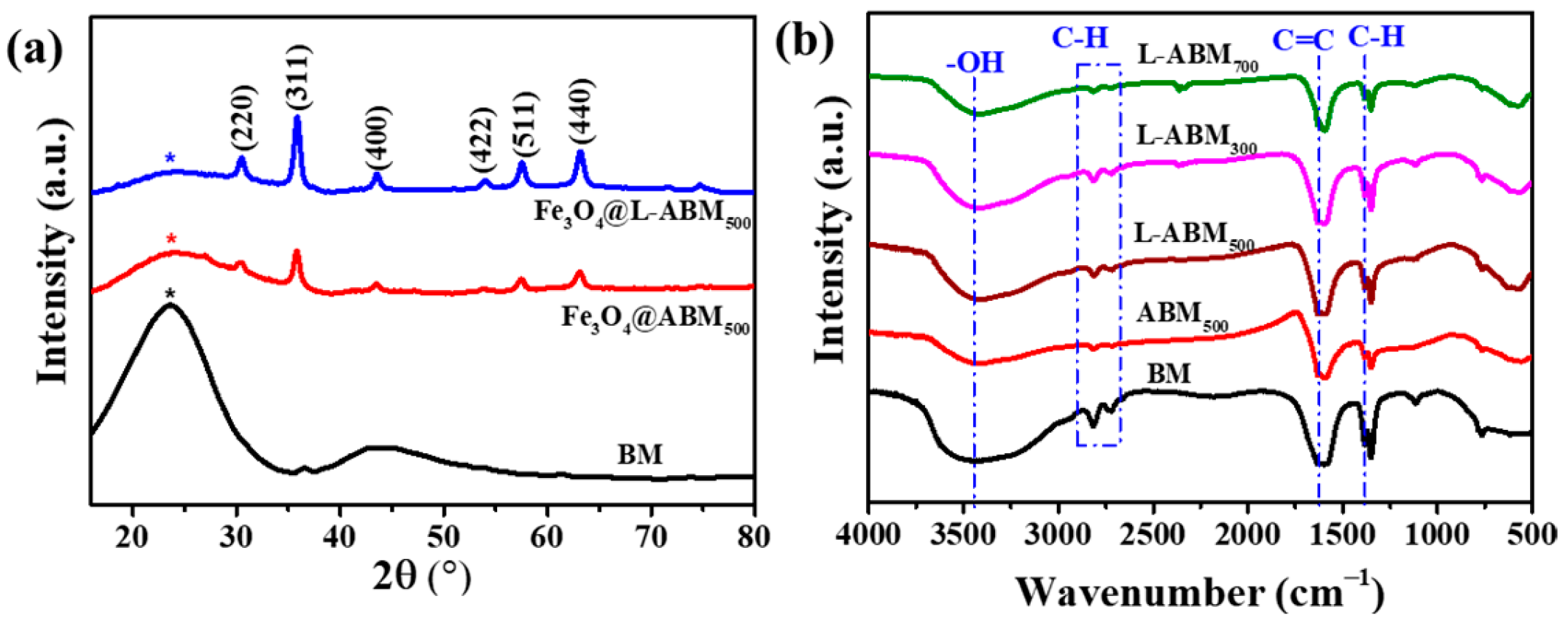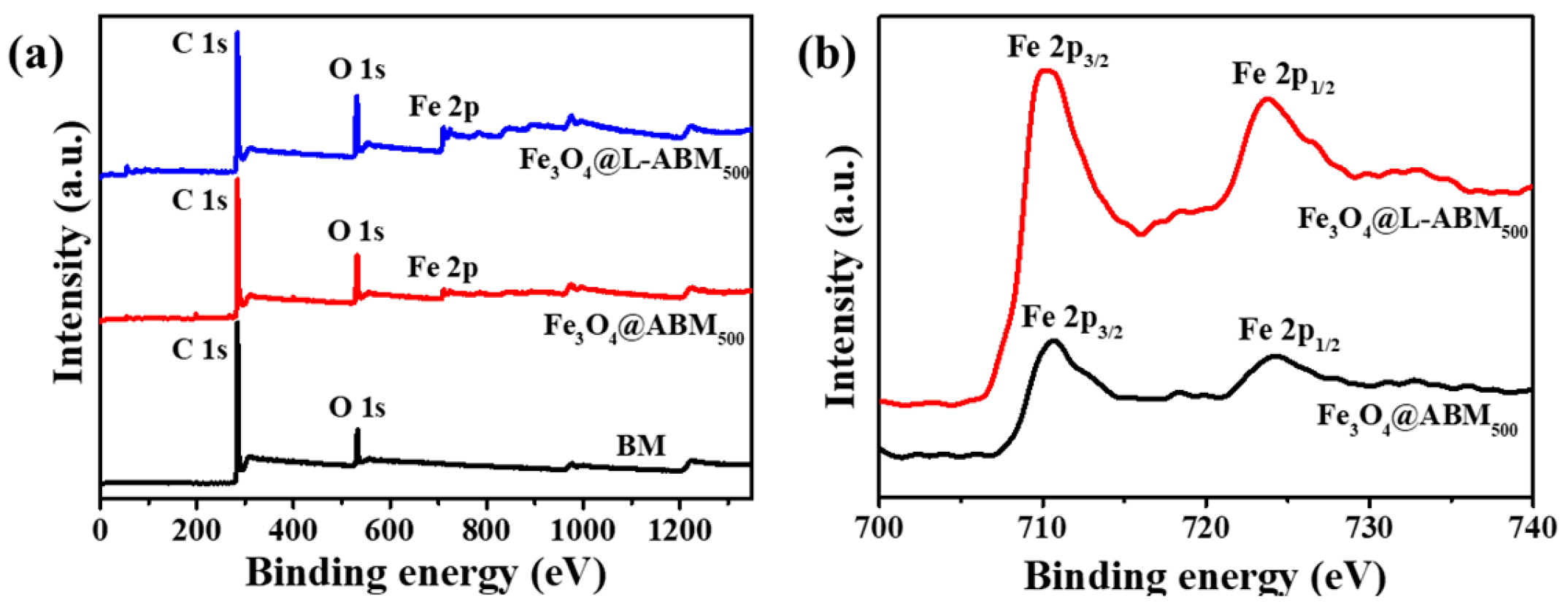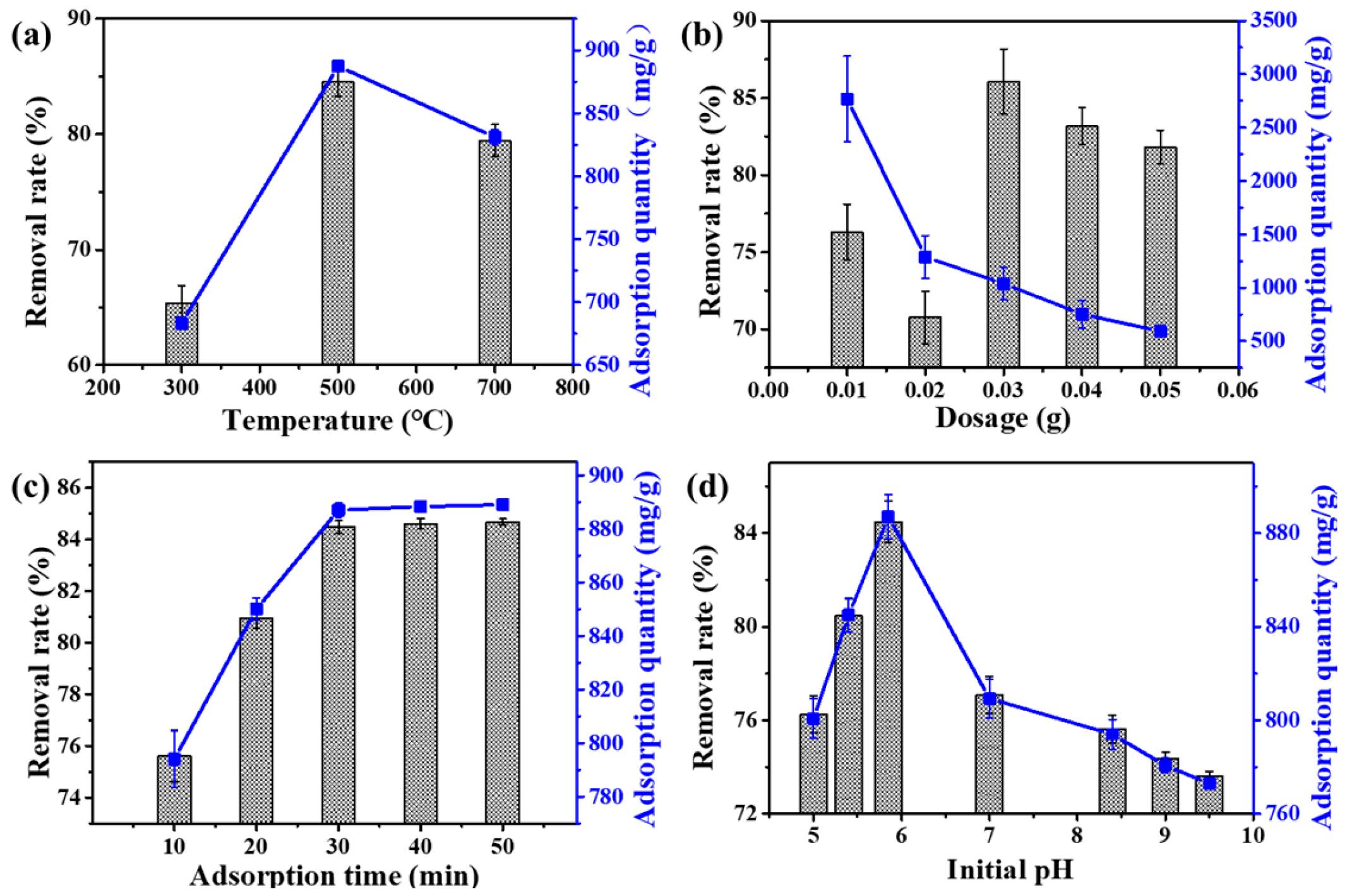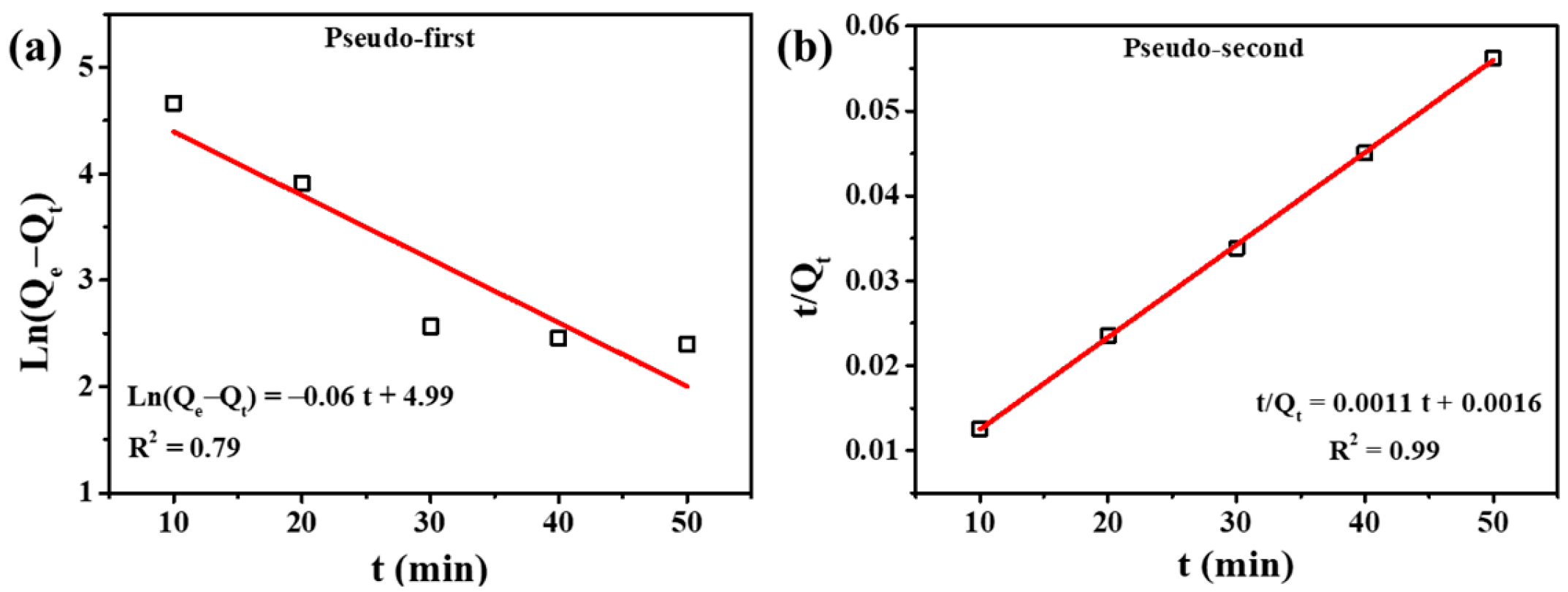Preparation of Biochar Composite Microspheres and Their Ability for Removal with Oil Agents in Dyed Wastewater
Abstract
:1. Introduction
2. Experimental Section
2.1. Materials and Chemicals
2.2. Preparation of Biochar Composite Microspheres
2.3. Adsorption Tests
2.4. Adsorption Kinetics
2.5. Analytical Methods
3. Results and Discussion
3.1. Characterizations
3.2. Adsorption Process Analysis
3.3. Adsorption Kinetics
4. Conclusions
Supplementary Materials
Author Contributions
Funding
Conflicts of Interest
References
- Han, J.; Dai, P.; Gu, C.; Liao, Y.; Zhao, Y.; Razaqpur, A.G.; Sun, G.; Chou, S. Emulsified oily wastewater treatment via fertilizer drawn forward osmosis using a corrugated thin film composite membrane. J. Membr. Sci. 2023, 685, 121926. [Google Scholar] [CrossRef]
- Chen, H.; Zhou, A.; Zhang, Y.; Wang, X.; Pan, G.; Xu, S.; Liu, Q.; Shan, H.; Fu, Q.; Ge, J. Carbonaceous nanofibrous membranes with enhanced superhydrophilicity and underwater superoleophobicity for effective purification of emulsified oily wastewater. Chem. Eng. J. 2023, 468, 143602. [Google Scholar] [CrossRef]
- Hosseini, M.K.; Liu, L.; Hosseini, P.K.; Lee, K.; Miao, J. Performance evaluation of a pilot-scale membrane filtration system for oily wastewater treatment: CFD modeling and scale-up design. J. Water Process Eng. 2023, 52, 103570. [Google Scholar] [CrossRef]
- Crini, G. Non-conventional low-cost adsorbents for dye removal: A review. Bioresour. Technol. 2006, 97, 1061–1085. [Google Scholar] [CrossRef] [PubMed]
- Jechan, L.; Seonho, L.; Young-Kwon, P. Reduction of odor-causing compounds in wastewater using biochar: A review. Bioresour. Technol. 2023, 385, 129419. [Google Scholar]
- Eniola, J.O.; Sizirici, B.; Khaleel, A.; Yildiz, I. Fabrication of engineered biochar-iron oxide from date palm frond for the effective removal of cationic dye from wastewater. J. Water Process Eng. 2023, 54, 104046. [Google Scholar] [CrossRef]
- Jia, H.; Sheng, Y.; Guo, P.; Underwood, S.; Chen, H.; Kim, Y.R.; Li, Y.; Ma, Q. Effect of synthetic fibers on the mechanical performance of asphalt mixture: A review. J. Traffic Transp. Eng. (Engl. Ed.) 2023, 10, 331–348. [Google Scholar] [CrossRef]
- Da Silva AF, V.; da Silva, J.; Vicente, R.; Ambrosi, A.; Zin, G.; Di Luccio, M.; de Oliveira, J.V. Recent advances in surface modification using polydopamine for the development of photocatalytic membranes for oily wastewater treatment. J. Water Process Eng. 2023, 53, 103743. [Google Scholar] [CrossRef]
- Ao, Y.; He, J.; Chen, K.; Zhu, M.; Ye, F.; Shen, L.; Yang, Y.; Feng, X.; Zhang, Z.; Tang, Y.; et al. Amine-functionalized cotton for the treatment of oily wastewater. Environ. Res. 2023, 237, 116882. [Google Scholar] [CrossRef] [PubMed]
- Gholamifard, H.; Rasul, M.G.; Rahideh, H.; Azari, A.; Abbasi, M.; Karami, R. Experimental and numerical analysis of oily wastewater treatment using low-cost mineral adsorbent in a single and multi-fixed bed column. Chem. Eng. J. Adv. 2023, 16, 100551. [Google Scholar] [CrossRef]
- Ma, J.; Chen, W.; Qian, J.; Shui, A.; Du, B.; He, C. Co-pressing and co-sintering preparation of cost-effective and high-performance asymmetric ceramic membrane for oily wastewater treatment. Sep. Purif. Technol. 2023, 323, 124373. [Google Scholar] [CrossRef]
- Jasim, M.A.; AlJaberi, F.Y.; Salman, A.D.; Alardhi, S.M.; Le, P.C.; Kulcsár, G.; Jakab, M. Studying the effect of reactor design on the electrocoagulation treatment performance of oily wastewater. Heliyon 2023, 9, e17794. [Google Scholar] [CrossRef] [PubMed]
- Sarup, R.; Sharma, M.; Behl, K.; Avasthi, D.K.; Kumar, P.; Ojha, S.; Nigam, S.; Joshi, M. Fabrication of superhydrophobic polyurethane sponge coated with oil sorbent derived from textile sludge for oily wastewater remediation. Environ. Nanotechnol. Monit. Manag. 2022, 18, 100675. [Google Scholar] [CrossRef]
- Zhai, S.; Li, M.; Wang, D.; Ju, X.; Fu, S. Cyano and acylamino group modification for tannery sludge bio-char: Enhancement of adsorption universality for dye pollutants. J. Environ. Chem. Eng. 2021, 1, 9. [Google Scholar] [CrossRef]
- Zhai, S.; Li, M.; Peng, H.; Wang, D.; Fu, S. Cost-effective resource utilization for waste biomass: A simple preparation method of photo-thermal biochar cakes (BCs) toward dye wastewater treatment with solar energy. Environ. Res. 2021, 194, 110720. [Google Scholar] [CrossRef]
- McMullan, G.; Meehan, C.; Conneely, A.; Kirby, N.; Robinson, T.; Nigam, P.; Banat, I.M.; Marchant, R.; Smyth, W.F. Microbial decolourisation and degradation of textile dyes. Appl. Microbiol. Biotechnol. 2001, 56, 81–87. [Google Scholar] [CrossRef]
- Donkadokula, N.Y.; Kola, A.K.; Naz, I.; Saroj, D. A review on advanced physico-chemical and biological textile dye wastewater treatment techniques. Rev. Environ. Sci. Bio/Technol. 2020, 19, 543–560. [Google Scholar] [CrossRef]
- Turesky, R.J.; Gross, G.A.; Stillwell, W.G.; Skipper, P.L.; Tannenbaum, S.R. Species differences in metabolism of heterocyclic aromatic amines, human exposure, and biomonitoring. Environ. Health Perspect. 1994, 102, 47–51. [Google Scholar]
- Liang, J.; Bing, C.; Baiyu, Z.; Xudong, Y. Modeling marine oily wastewater treatment by a probabilistic agent-based approach. Mar. Pollut. Bull. 2018, 127, 217–224. [Google Scholar]
- Navarathna, C.M.; Bombuwala Dewage, N.; Keeton, C.; Pennisson, J.; Henderson, R.; Lashley, B.; Zhang, X.; Hassan, E.B.; Perez, F.; Mohan, D.; et al. Biochar adsorbents with enhanced hydrophobicity for oil spill removal. ACS Appl. Mater. Interfaces 2020, 12, 9248–9260. [Google Scholar] [CrossRef]
- Wen, Q.; Chen, Y.; Rao, X.; Yang, R.; Zhao, Y.; Li, J.; Xu, S.; Liang, Z. Preparation of magnesium Ferrite-Doped magnetic biochar using potassium ferrate and seawater mineral at low temperature for removal of cationic pollutants. Bioresour. Technol. 2022, 350, 126860. [Google Scholar] [CrossRef]
- Meng, Z.; Huang, S.; Xu, T.; Lin, Z.; Wu, J. Competitive adsorption, immobilization, and desorption risks of Cd, Ni, and Cu in saturated-unsaturated soils by biochar under combined aging. J. Hazard Mater. 2022, 434, 128903. [Google Scholar] [CrossRef] [PubMed]
- Ferreira, C.I.; Calisto, V.; Otero, M.; Nadais, H.; Esteves, V.I. Comparative adsorption evaluation of biochars from paper mill sludge with commercial activated carbon for the removal of fish anaesthetics from water in Recirculating Aquaculture Systems. Aquac. Eng. 2016, 74, 76–83. [Google Scholar] [CrossRef]
- Zhu, H.; Li, L.; Chen, W.; Tong, Y.; Wang, X. Controllable synthesis of coral-like hierarchical porous magnesium hydroxide with various surface area and pore volume for lead and cadmium ion adsorption. J. Hazard Mater. 2021, 416, 125922. [Google Scholar] [CrossRef] [PubMed]
- Xiao, C.; Song, Q.; Shen, Q.; Wang, T.; Xie, W. Understanding on interlaminar nano-reinforcement induced mechanical performance improvement of carbon/carbon composites after silicon infiltration. Compos. Part B Eng. 2022, 239, 109946. [Google Scholar] [CrossRef]
- Regazzoni, A.E. Adsorption kinetics at solid/aqueous solution interfaces: On the boundaries of the pseudo-second order rate equation. Colloids Surf. A Physicochem. Eng. Asp. 2020, 585, 124093. [Google Scholar] [CrossRef]
- Ezzati, R. Derivation of Pseudo-First-Order, Pseudo-Second-Order and Modified Pseudo-First-Order rate equations from Langmuir and Freundlich isotherms for adsorption. Chem. Eng. J. 2020, 392, 123705. [Google Scholar] [CrossRef]
- Ga, S.; An, N.; Joo, C.; Kim, J. pyAPEP: An all-in-one software package for the automated preparation of adsorption process simulations. Comput. Phys. Commun. 2023, 291, 108830. [Google Scholar] [CrossRef]






| Model | Fitting Parameters | Values |
|---|---|---|
| Pseudo-first-order equation | K1 (min−1) | 0.06 |
| Qe (mg/g) | 146.94 | |
| R2 | 0.79 | |
| Pseudo-second-order equation | K2 (g/(mg·min)) | 7.56 × 10−4 |
| Qe (mg/g) | 909.11 | |
| R2 | 0.99 |
Disclaimer/Publisher’s Note: The statements, opinions and data contained in all publications are solely those of the individual author(s) and contributor(s) and not of MDPI and/or the editor(s). MDPI and/or the editor(s) disclaim responsibility for any injury to people or property resulting from any ideas, methods, instructions or products referred to in the content. |
© 2023 by the authors. Licensee MDPI, Basel, Switzerland. This article is an open access article distributed under the terms and conditions of the Creative Commons Attribution (CC BY) license (https://creativecommons.org/licenses/by/4.0/).
Share and Cite
Shen, L.; Jin, R.; Chen, W.; Qi, D.; Zhai, S. Preparation of Biochar Composite Microspheres and Their Ability for Removal with Oil Agents in Dyed Wastewater. Materials 2023, 16, 6155. https://doi.org/10.3390/ma16186155
Shen L, Jin R, Chen W, Qi D, Zhai S. Preparation of Biochar Composite Microspheres and Their Ability for Removal with Oil Agents in Dyed Wastewater. Materials. 2023; 16(18):6155. https://doi.org/10.3390/ma16186155
Chicago/Turabian StyleShen, Lu, Rushi Jin, Wanming Chen, Dongming Qi, and Shimin Zhai. 2023. "Preparation of Biochar Composite Microspheres and Their Ability for Removal with Oil Agents in Dyed Wastewater" Materials 16, no. 18: 6155. https://doi.org/10.3390/ma16186155
APA StyleShen, L., Jin, R., Chen, W., Qi, D., & Zhai, S. (2023). Preparation of Biochar Composite Microspheres and Their Ability for Removal with Oil Agents in Dyed Wastewater. Materials, 16(18), 6155. https://doi.org/10.3390/ma16186155





